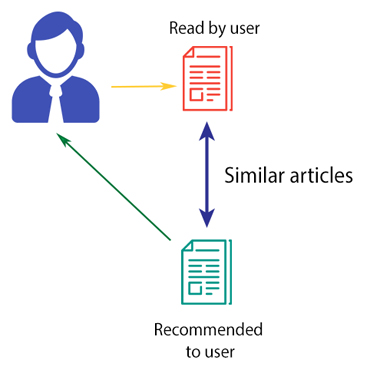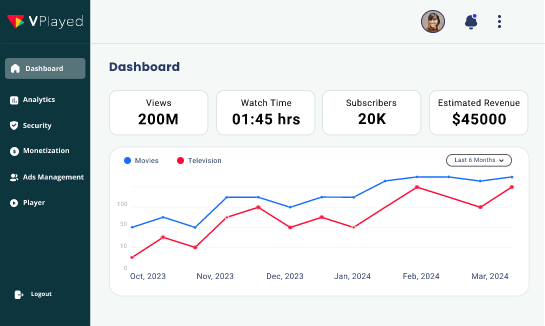How VPlayed Utilized Machine Learning In Video Recommendation Engines For Better Viewer Engagement

Ever started watching a World War II documentary on YouTube and ended up watching cat videos 6 hours later? This is the power of a recommendation engine.
Recommendation engines and machine learning are all the rage these days and are being employed in every single product-based business. Their viewer engagement and experience-enhancing powers are so far one of the best in the market, much better than PWAs (Progressive Web Apps).
Providing targeted marketing techniques, recommendation engines have been successful in conversion strategies and customer experience management. They are being implemented across multiple vertices like e-commerce, banking, medicine, search engines, etc. But we’re going to see the effects they have on one particular industry – the OTT platform industry.
Table of Contents
What Are Recommendation Engines?
Recommendation engines utilise the power of data, machine learning and algorithms to guide consumers to content relevant to them. This creates a positive impact on consumer experience and instigates them to return on the platform.
For eg., someone who is new on Netflix might want to watch Narcos. After they’re done registering, they immediately search for Narcos. In that search page, Narcos is the first result among many others, which are generated by the recommendation engine according to the pre-existing data of other Netflix users.
By doing so, viewers retain the visual information of that search page and are more likely to view other series that are similar to Narcos.
Similarly, the homepage also includes a lot of suggestions for viewers to ponder over. These suggestions are generated by the recommendation engine using the user’s viewing history, searches, preferences, location and other variables that define that user’s engagement with the platform.
Is All This Hassle Really Necessary?
While it would seem like quite a complex and hectic undertaking, installing a recommendation engine is quite beneficial.
- It increases the viewer’s engagement with the platform.
- It improves the brand value of the company.
- It enhances the viewer retention rate of the platform.
- It creates a personalised experience for the users.
- Users are more likely to renew their subscription owing to the vast “understanding” the platform has for their likes and dislikes.
How Does Vplayed’s Recommendation Engine Works?
Types Of Recommendation Algorithms Vplayed Follows
This is where things get a little technical.
There are several different types of algorithms implemented in different places on our video on demand platform according to the kind of response expected from the user.
Content-based Filtering

Recommendations rely on the context and the properties of each video or audio file including genre, meta information, cast, etc. This has a high Root Mean Square Error (RMSE) value, although the accuracy increases with use.
Collaborative Filtering

Recommendations are independent of context and rely solely on the behaviour and preferences of the viewer in relation to other users.
For example, if my Neighbour1 like ‘Friends’, ‘Lucifer’ and ‘Stranger Things’ and my Neighbour2 likes ‘Stranger Things’, ‘Friends’ and ‘Narcos’, then it is highly likely that my Neighbour1 will like ‘Narcos’ and my Neighbour2 will like ‘Lucifer’ because of their similar fondness for ‘Friends’ and ‘Stranger Things’.
There are several drawbacks and conditions aligned with collaborative filtering like the cold-start problem (discussed ahead), low scalability and content repetition.
Low-rank Matrix Factorization
It is a class of collaborative filtering where a user-item interaction matrix is created, which is then reduced to a product of 2 low-rank rectangular matrices.
In simple terms, it reduces the number of predictors for faster and more accurate computation and to enable the use of certain statistical methods that require a high ‘observation per predictor’ ratio. This process is known as Dimensionality Reduction. It produces a much lower RMSE.
Deep Learning
Deep learning is Machine learning ‘on steroids’. It utilizes neural networks to ‘learn’ item and user attributes and predict interactions and ratings. As opposed to wide linear models, deep neural networks can find and memorize secret feature interactions through low dimensional embedding.
This is only the tip of the iceberg. There is a lot that goes into constructing a successful recommendation architecture from scratch.
The Cold-Start Problem
Collaborative filtering works when we have certain pre-existing data about the users. This is not true in the case of a new user. For a new user, there is no initial information that’ll get the algorithm going.
To tackle this, deep learning can be utilized which essentially combines both content-based and collaborative filtering techniques. When a new user registers, content-based filtering can be run with the aid of a few ‘recommendation questions’. The questions allow the engine to gather initial information to jump start and provide relevant recommendations instantly.
Recommendation Engine Best Practices
It is essential to initiate a recommendation strategy correctly and intelligently. Here are a few tips to keep in mind while doing so.
Track User-Item Interactions
User-item interactions are trackable and very useful to develop a strong recommendation engine.
Store Only Useful Information
In order to save essential space, track and save only information that may serve useful in the future.
Control Frequency Of Recommended Content
Keep in check how often you want your recommendation engine to show suggestions and where.
Analyze Recency-Ranking Relation
Get a balance between showing new content and showing high-rated content as both are equally important.
Learn More About Users
Knowing more about your audience only help in developing a better engine that will provide a much smoother user experience.
Handle The Cold-Start Problem
Cold start is a big problem but easy to tackle. See what kind of approach you want to take around this problem and make your business model around it.
Conclusion
We have learnt a lot about how Vplayed’s recommendation engine and its functionality. It is a one-of-a-kind suggestion machine that can improve viewer experience, retention time and engagement with content both on-platform and off-platform.

